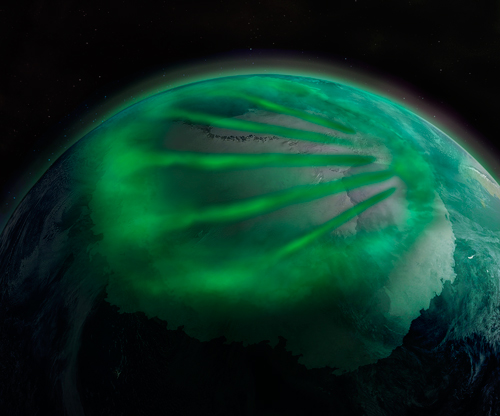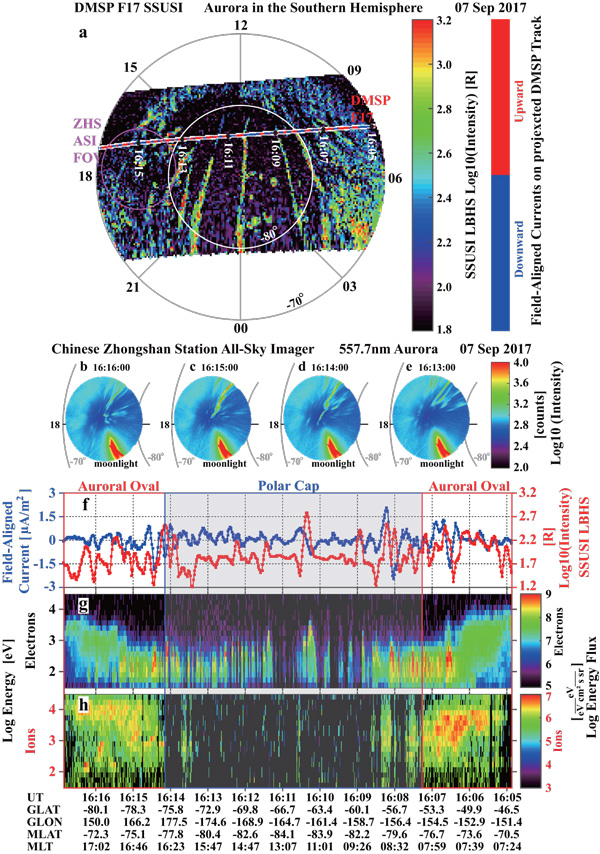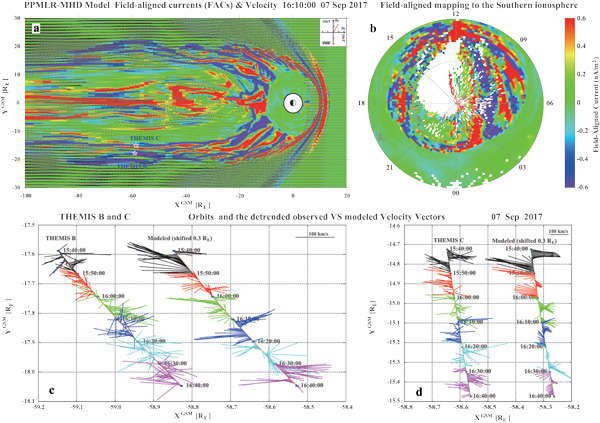2020 ARTEMIS SCIENCE NUGGETS
Multiple transpolar auroral arcs reveal insight about coupling processes in the Earth’s magnetotail
by Qing-He Zhang
Shandong Provincial Key Laboratory of Optical Astronomy and Solar-Terrestrial Environment,
Institute of Space Sciences, Shandong University, Weihai, Shandong, 264209, China.
Introduction
Colorful and dynamic aurora have attracted humans’ attention since the dawn of time. However, a mystery remained in understanding a distinct class of aurora, called transpolar auroral arc (TPA) that stretches almost entirely across the polar cap and connects the dayside and nightside auroral oval. In some cases called “theta” aurora, it appears in the extremely high latitude ionosphere of Earth when the interplanetary magnetic field (IMF) is northward, which occurs nearly half of the time. The formation and evolution of TPA offers clues about the processes of energy and momentum transfer from the solar wind to the magnetosphere and ionosphere, during northward IMF. The associated auroral particle precipitation can cause ionospheric scintillations, which can disrupt communications and navigation in the polar regions.
| Figure 1. Artistic rendering of bright multiple transpolar auroral arcs across the Earth's southern polar ionosphere. Image courtesy of Qing-He Zhang. |
However, the causes of TPA have been debated for decades. A number of theories or concepts have been proposed but they are unable to explain all of the observed features of TPA, especially the multiple TPAs (see the sketch in Figure 1) and their formation remains poorly understood and controversial. In order to in investigate this unsolved scientific problem, this paper presents ground-breaking multiple-instrument observations of multiple TPA structures seen simultaneously both in the ionosphere and the distant magnetotail. The observations are interpreted using a global 3D MagnetoHydroDynamics (MHD) simulation, giving for the first time a discussion of the formation of multiple TPAs from a global perspective.
Observation and Simulation Results
By using comprehensive observations from the DMSP satellite in the ionosphere, ARTEMIS satellites in the distant magnetotail, all-sky imager at the Chinese Antarctic Zhongshan research station, and comparing with a high-resolution 3D global MHD simulation, a new mechanism had been identified by Zhang et al. [2020].
On 7 September 2017, long-lasting, relatively stable northward IMF conditions (IMF Bz > 0 for more than 8 hours) occurred with comparable dawn–dusk components (IMF By) and roughly stable solar wind and quiet geomagnetic conditions. Under these conditions, auroral observations from the Southern Hemisphere are available and presented in Figure 2. Poleward of a normal auroral oval at lower latitudes, Figure 2a shows at least six bright transpolar arcs (TPAs) in the otherwise empty polar cap (several of the TPAs were brighter than the main auroral oval with brighter spots within them). Figure 2b-e shows the time evolution of the aurora during an overflight by the DMSP F17 spacecraft of one TPA, as recorded by a 557.7 nm all-sky imager at the Zhongshan Station (ZHS). The projected field-aligned current (FAC) along the satellite track suggests that each arc was associated with an upward FAC (Figure 2a and 2f). Minor offsets can be attributed to altitude differences between the two data sets. The in-situ plasma observations of the electron energy flux (Figure 2g) show that each auroral arc was associated with precipitation of electrons that have been accelerated to more than 1keV.
| Figure 2. Aurora and in-situ plasma and field-aligned current observations in the Southern Hemisphere. (a) Aurora in the LBH-S band (wavelength of 140-150 nm) observed by the SSUSI instrument on board the DMSP F17 satellite from JHU/APL and the sign of the field-aligned currents (FACs) shown in red and blue color along the satellite track. The FAC is calculated from the SSM magnetic field measurement on board the satellite, (b-e) sequence of 557.7 nm aurora images from the all-sky imager at the Chinese Antarctic Zhongshan Station (ZHS), (f) time series of the calculated FACs and the aurora intensity extracted from Figure 2a along the track of DMSP F17, and (g) and (h) electron and ion energy flux spectrograms from JHU/APL SSJ4 instrument on board the DMSP F17. The magenta ellipse in Figure 2a shows the field-of-view (FOV) of the ZHS all-sky imager. Figures 2b-h are shown in the reversed order to better align with the DMSP F17 trajectory in Figure 2a; i.e. time runs from the right to the left (dusk to the left, dawn to the right). |
Using the measured interplanetary conditions as input, a high-resolution 3-D global MHD code called PPMLR-MHD, was run to investigate the formation of multiple TPAs. The simulation results in Figure 3a show a large number of filamentary FACs and associated flow shears in both the magnetospheric boundary produced by Kelvin-Helmholtz instability (KHI) between super-sonic solar wind flow and magnetosphere plasma, and the plasma sheet generated by the interactions between the enhanced earthward plasma flows from the distant tail (less than -100 RE) and the enhanced tailward flows from the near tail (about -20 RE). When the FACs are mapped along the magnetic field to the ionosphere in the Southern Hemisphere, a striking pattern emerges (Figure 3b). The mapped FACs show clear cusp-aligned, “arc-like” structures in both the polar cap and the auroral oval that are similar in shape and size to the observed arcs shown in Figure 2a.
To verify the simulation results, this paper presents simultaneous observations from spacecraft B and C of the ARTEMIS mission near the equatorial plane in the dawnside magnetotail. These spacecraft were in an orbit around the moon at [-59.0, -17.8, 4.0] and [-58.6, -15.1, 3.8] RE GSM, respectively. Red stars in Figure 3a mark the locations of each spacecraft, which both observed multiple flow shears in the X-Y plane that remarkably well resemble those from the Kelvin-Helmholtz instability within the model (see Figure 3c and 3d). In this analysis, the data have been detrended by subtracting the mean velocity. The results confirm that there are indeed strong flow shears in the magnetospheric boundary layer, triggering Kelvin-Helmholtz instability between the solar wind and magnetosphere. Both the simulation results and the ARTEMIS observations show very similar behavior (Figure 3c and 3d), which adds confidence that the PPMLR-MHD model is indeed capturing the key physical processes for these northward IMF conditions.
| Figure 3. An extract from a movie of the simulated field-aligned currents (FACs) and plasma velocity vectors in the X-Y plane in GSM coordinates. (a) 2-D distribution of FACs and plasma velocity vectors in the equatorial plane of the magnetosphere simulated by the PPMLR-MHD code; (b) field-aligned mapping of the FACs from the equatorial plane of the magnetosphere to the ionosphere in the Southern Hemisphere; (c) and (d) the time series of the detrended plasma velocity vectors observed by the THEMIS B and C satellites and PPMLR-MHD model simulation results near the satellites locations (marked by red stars in Figure 3a). The vectors in Figure 3c and 3d are shown using different colors every 10 minutes. Both the observations and the simulation results are shown at 20 s time resolution, and the simulation results have been offset by 0.3 RE in the X direction in Figure 3c and 3d for easier comparison. |
Conclusions
This paper reports a new mechanism identified from multiple-instrument observations of unusually bright, multiple TPAs and simulations from a high-resolution three-dimensional global MHD model. The observations and simulations show an excellent agreement and reveal that these multiple TPAs are generated by precipitating energetic magnetospheric electrons within field-aligned current (FAC) sheets. These FAC sheets are generated by multiple flow shear sheets in both the magnetospheric boundary produced by Kelvin-Helmholtz instability between super-sonic solar wind flow and magnetosphere plasma, and the plasma sheet generated by the interactions between the enhanced earthward plasma flows from the distant tail (less than -100 RE) and the enhanced tailward flows from the near tail (about -20 RE). This should be a general mechanism for the formation of all the auroral arcs. The study offers a new insight into the complex solar wind-magnetosphere-ionosphere coupling processes under a northward IMF condition, and it challenges existing paradigms of the dynamics of the Earth’s magnetosphere.
References
Zhang, Q. -H., et al. (2020), Multiple transpolar auroral arcs reveal insight about coupling processes in the Earth’s magnetotail, Proc. Natl. Acad. Sci. USA (PNAS), 117(28), doi: 10.1073/pnas.2000614117Biographical Note
Dr. Qing-He Zhang is a professor at Institute of Space Sciences, Shandong University, China, and leads a group of ionosphere-magnetosphere coupling and space weather research as a PI. He and his group focus on the research of ionosphere-magnetosphere coupling and the associated space weather effects, and have made a series of progresses, such as fully tracking the large-scale Dungey convection cycle by using polar cap ionospheric patches, etc. Relevant works have been published in Science as an issue highlight [Zhang et al., Science, 339, 1597-1600 (2013)] and in Journal Geophysics Researches: Space Physics as a cover letter paper [Zhang et al., JGR, 121, 9063–9074 (2016)], etc.
 Please send comments/suggestions to
Emmanuel Masongsong / emasongsong @ igpp.ucla.edu
Please send comments/suggestions to
Emmanuel Masongsong / emasongsong @ igpp.ucla.edu


